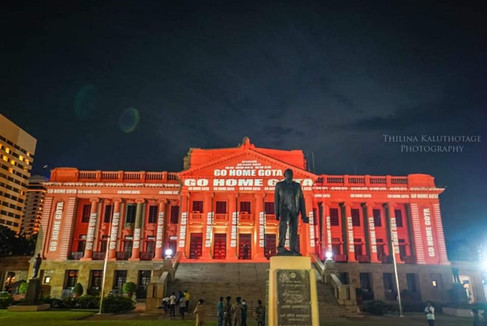The Sri Lankan Economic Crisis 2022 - Protest Analysis
- Tia Goonaratna

- Apr 15, 2022
- 2 min read
Images taken from Facebook and Instagram.
Sri Lanka is currently going through an economic crisis and is in deficit. Those directly responsible for this is the President and his family members who hold positions such as Prime Minister, Minister of Youth and Sports, and Chief of Staff among many others. Over the last 15 years or so, they have been slowly stealing from the country’s budget and the country finally stood up them in the beginning of April, 2022. With severe power cuts going up to 16 hours a day, finite fuel and gas, and with the rise of groceries, people took to the streets.
In the past, these protests have been controlled by offering a rice packet and a half a bottle of alcohol to people from rural areas to come and ‘pretend’ to protest. With this current protest, organically generated from people showed a different side to Sri Lanka. The main focal point of the protest has been its peaceful nature. There has been no violence, no looting, and no rioting. Instead there has been singing, art sculptures, dancing, stage dramas, and creativity.
For years, Sri Lankans believed we had a ‘race issue’ based on different religious conflicts. During this protest, it has been evident that people of all religions and races are coming together on a more united front and there are no racial confrontations taking place. The protestors, protesting in front of the Galle Face Green, established the place as ‘GotaGo Village’ making it clear that their only demand is the current president, Gotabhaya Rajapaksa, to go home.
Within this village, they have established a university, a school, a library, and a hospital to cater to those who are coming to the protest.
The protest site is litter free, and plastic bottles leftover has been utilised to create art installations.
They have also combined technology by using 3D mapping to project their ‘message’ on to the Old Parliament Building, to create light art, and by establishing a WIFI and hotspot centre.
The most interesting conditioning disrupter was when the Prime Minister, Mahinda Rajapaksa invited them to sit and talk about their demands, the variety of responses can be categoried easily by the generation gap. While Boomers and Gen X saw it in a positive light, the Millenials and Gen Z wrote a letter back saying ‘We told you what we want. Please go’.
This protest got me reflecting on two things; How much conditioning do we have from the older generations and who is teaching Gen Z to be this brave and creative? As an outcome of the local education system, I am confident this much creativity was not borne out of it. Withing the last 15 days, I saw a mix of experts almost broken by generations. Even to this day, those who try to disrupt, to point fingers, or to bring in extremist ideas are done almost solely by Boomer Generation. Gen X is showing solidarity and are asking for rational solutions. However, the Millennials and Gen Z are working towards a complete shift, but not without being armed with information. Information is freely shared, and the relatively new Bar Association are working tirelessly, pro bono, going against the system for the first time.
Who is teaching them all this?






































































Comments